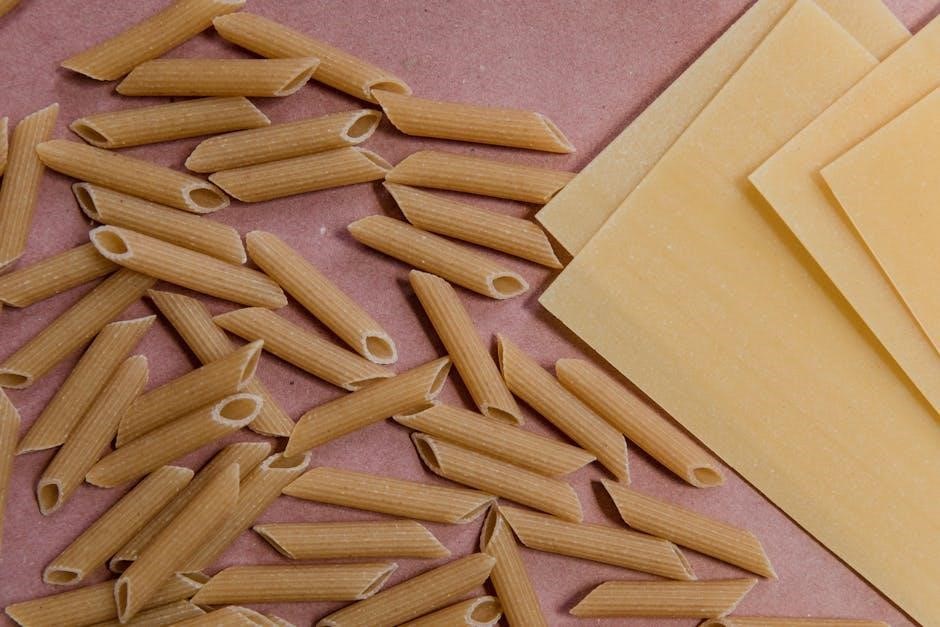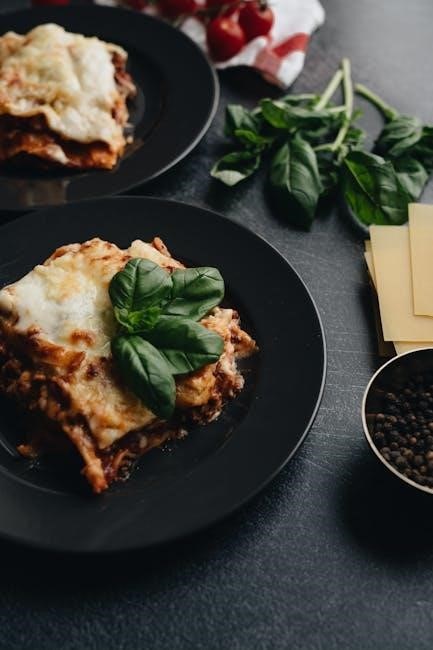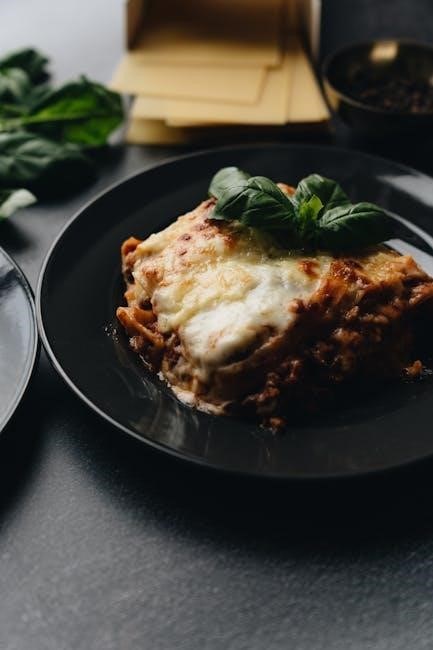
Stouffer’s Lasagna Cooking Instructions
Stouffer’s lasagna offers convenient meal options, available in various sizes like Family and Party Size. Cooking instructions generally involve oven baking, with specific times depending on whether the lasagna is frozen or thawed. Always refer to the package for precise directions, as cooking times can vary.
Preparation: Frozen vs. Thawed
When preparing Stouffer’s lasagna, the initial consideration is whether to cook it from a frozen or thawed state. Cooking from frozen is the most common and convenient method, requiring a longer baking time to ensure the lasagna is heated thoroughly. The package instructions will provide the specific time and temperature for frozen preparation, typically involving covering the lasagna for a portion of the cooking time and then uncovering it to brown the top.
Thawing the lasagna beforehand can reduce the overall cooking time. If choosing to thaw, it’s crucial to do so safely in the refrigerator (at 40 degrees F or less) for an extended period, potentially overnight. Once thawed, the cooking time will be significantly shorter compared to cooking from frozen; again, refer to the package instructions for the exact duration and temperature.
Regardless of whether you cook from frozen or thawed, always ensure the lasagna reaches an internal temperature of 165 degrees F for food safety and quality. Using a food thermometer is the best way to confirm that the lasagna is heated through before serving.
Oven Cooking Instructions: Temperature and Time
Oven cooking is the recommended method for preparing Stouffer’s lasagna, providing even heating and a desirable texture. The ideal oven temperature typically falls between 375°F and 400°F, but always consult the specific instructions on your lasagna’s packaging, as variations may exist based on size and ingredients.
Cooking time is heavily influenced by whether the lasagna is frozen or thawed. A frozen lasagna will require a significantly longer baking period, generally ranging from 70 to 100 minutes. Thawed lasagna, on the other hand, needs a shorter time, usually around 65 minutes.
The cooking process often involves two stages: baking covered and baking uncovered. Initially, the lasagna is baked covered (either with the film provided or with aluminum foil) to trap moisture and ensure even heating throughout. Towards the end of the cooking time, the cover is removed to allow the top layer of cheese to melt, brown, and achieve a slightly crispy texture. Always use a baking sheet underneath the lasagna to catch any spills and ensure even heat distribution.

Oven Cooking: Baking Sheet Placement
When oven-cooking Stouffer’s lasagna, proper baking sheet placement is crucial for ensuring even heating and preventing potential messes. Always position the baking sheet on the center rack of your preheated oven. This central location promotes uniform heat distribution around the lasagna, leading to consistent cooking throughout.
Avoid placing the baking sheet too high or too low in the oven. If positioned too high, the top of the lasagna may brown too quickly or even burn before the center is fully heated. Conversely, placing it too low can result in an undercooked top and unevenly heated interior.
Using a baking sheet is essential for several reasons. First, it provides a stable and level surface for the lasagna, preventing it from tilting or spilling during cooking. Second, it acts as a barrier to catch any drips or overflows from the lasagna as it heats up, saving you from a messy oven cleanup. Third, the baking sheet helps distribute heat evenly to the bottom of the lasagna, preventing hot spots and ensuring consistent cooking from all sides.

Oven Cooking: Lid Usage (Covered vs. Uncovered)
The use of a lid during oven cooking of Stouffer’s lasagna plays a significant role in the final outcome, impacting both moisture retention and browning. Initially, keeping the lasagna covered is generally recommended. This is often achieved by leaving the film on the tray or using the original lid, slightly tented, to allow steam to escape while still trapping moisture.
Covering the lasagna during the initial baking phase helps to prevent the top from drying out and ensures that the interior heats evenly. The trapped steam aids in thoroughly cooking the noodles and melting the cheese without excessive browning. This is particularly important when cooking from a frozen state.
Toward the end of the cooking time, removing the lid is essential for achieving the desired golden-brown finish on the top layer of cheese. This uncovered phase allows excess moisture to evaporate, concentrating the flavors and creating a more visually appealing and texturally satisfying crust. It’s crucial to monitor the lasagna closely during this stage to prevent over-browning or burning. The exact timing for lid removal may vary depending on the specific lasagna size and oven characteristics.
Oven Cooking: Tent Method

The tent method, often recommended when oven-cooking Stouffer’s lasagna, is a technique designed to regulate browning and prevent the top layer from becoming excessively dark before the lasagna is fully heated through. This is especially useful for larger family-size or party-size lasagnas, which require longer cooking times.
The tent is typically created using the lasagna’s original lid or a sheet of aluminum foil. The lid or foil is bent slightly in the middle, creating a ridge that runs the length of the tray. This ridge elevates the cover, leaving a small gap between the lasagna’s surface and the tent.
This elevated tent serves several purposes. First, it shields the top of the lasagna from direct heat, slowing down the browning process. Second, the small gap allows steam to escape, preventing the lasagna from becoming overly soggy. Finally, it maintains a humid environment within the covered space, which helps to cook the lasagna evenly.
The tent is usually employed for the majority of the cooking time. Near the end, the tent is removed to allow the cheese to melt and brown to a desirable golden color. Monitoring the lasagna during this final stage is important to avoid burning.
Microwave Cooking Instructions
While oven cooking is often preferred for optimal texture and flavor, microwave cooking offers a faster alternative for preparing Stouffer’s lasagna, especially for individual portions or when time is limited. However, it’s crucial to follow specific microwave instructions to ensure the lasagna is cooked thoroughly and safely.
Microwave instructions typically involve covering the lasagna with microwave-safe plastic wrap, vented to allow steam to escape. Cooking times vary depending on the wattage of your microwave. It is essential to consult the package instructions for specific timings based on your microwave’s power level.
Generally, microwaving involves several stages. Initially, the lasagna is cooked on high power for a set duration. Then, the power level is often reduced to medium or 50% to ensure even heating without overcooking the edges. A standing time is usually recommended after microwaving to allow the heat to distribute evenly throughout the lasagna.
Carefully remove the lasagna from the microwave, as the dish may be hot. Check the internal temperature to ensure it has reached a safe level. If the lasagna is not fully heated, continue microwaving in short intervals until it reaches the desired temperature.
Microwave Cooking: Wattage Considerations
When utilizing a microwave to cook Stouffer’s lasagna, wattage plays a crucial role in determining the appropriate cooking time. Microwaves with higher wattage cook food more quickly than those with lower wattage. Therefore, it’s essential to adjust cooking times according to your microwave’s specifications to prevent undercooking or overheating the lasagna.
The cooking instructions provided on the Stouffer’s lasagna packaging typically offer guidelines for different wattage levels. If your microwave’s wattage falls between the specified ranges, you may need to adjust the cooking time accordingly. For instance, if the instructions provide timings for 1000-watt and 700-watt microwaves, and your microwave is 850 watts, you’ll need to estimate the cooking time based on the proportional difference.
Undercooking can lead to unevenly heated lasagna and potential health risks, while overheating can result in dry, rubbery textures. To ensure optimal results, it’s advisable to start with the minimum recommended cooking time and then check the lasagna’s internal temperature. If necessary, continue microwaving in short intervals, checking the temperature each time, until the lasagna is thoroughly heated. Remember, patience and careful monitoring are key to successful microwave cooking.

Checking for Doneness: Internal Temperature
Ensuring your Stouffer’s lasagna is thoroughly cooked is paramount for both safety and optimal taste. Relying solely on visual cues can be misleading; therefore, verifying the internal temperature is crucial. The recommended internal temperature for cooked lasagna is 165°F (74°C).
To accurately measure the internal temperature, use a food thermometer; Insert the thermometer into the center of the lasagna, avoiding contact with the edges or the dish itself, as these areas may heat up more quickly. Ensure the thermometer is placed in the thickest part of the lasagna to obtain the most reliable reading.
If the internal temperature falls below 165°F (74°C), continue cooking the lasagna, checking the temperature every few minutes until the desired temperature is reached. Remember, it’s better to err on the side of caution and ensure the lasagna is fully heated.
Once the lasagna reaches the appropriate internal temperature, remove it from the oven or microwave. Let it rest for the recommended time before serving. This resting period allows the lasagna to further cook and for the flavors to meld, resulting in a more delicious and satisfying meal. Always prioritize safety and accuracy when checking for doneness.
Resting Time After Cooking
After the Stouffer’s lasagna has reached the recommended internal temperature and is removed from the oven or microwave, allowing it to rest is a crucial step often overlooked; This resting period significantly impacts the final texture and overall enjoyment of the dish. Typically, a resting time of 5 to 15 minutes is advised.
During this time, the internal temperature of the lasagna continues to equalize, ensuring that the heat is evenly distributed throughout. This process helps to prevent the lasagna from being too runny or falling apart when sliced. The starches in the pasta and sauce also have time to absorb moisture, resulting in a firmer and more cohesive structure.
Moreover, resting allows the flavors within the lasagna to meld and deepen. The herbs, spices, and savory components have an opportunity to fully integrate, creating a more harmonious and flavorful experience. Cutting into the lasagna immediately after cooking can cause the internal juices to escape, leading to a drier and less flavorful dish. Therefore, patience during the resting period is key.
To maintain the lasagna’s warmth while resting, you can loosely tent it with foil. However, avoid wrapping it too tightly, as this can trap steam and cause the top layer to become soggy.
Serving Suggestions
Once your Stouffer’s lasagna has rested to perfection, the possibilities for serving are delightfully diverse. For a classic and comforting meal, a simple side salad with a light vinaigrette provides a refreshing counterpoint to the richness of the lasagna. Consider using mixed greens, crisp lettuce, or even a vibrant Caprese salad with fresh mozzarella and tomatoes.
To elevate the experience, a warm slice of garlic bread or crusty Italian bread is always a welcome addition. These accompaniments are perfect for soaking up the savory sauce and complementing the textures of the lasagna. You can even toast the bread with a sprinkle of Parmesan cheese for an extra layer of flavor.
For a more substantial meal, consider pairing the lasagna with roasted vegetables. Broccoli, asparagus, or bell peppers, seasoned with herbs and a drizzle of olive oil, offer a healthy and flavorful side dish. Alternatively, a simple steamed vegetable like green beans or spinach can provide a nutritious and colorful contrast.
Wine pairings can also enhance the dining experience. A light-bodied red wine, such as Chianti or Pinot Noir, complements the tomato-based sauce and savory flavors of the lasagna. For those who prefer white wine, a crisp Pinot Grigio or Sauvignon Blanc can provide a refreshing contrast.
Customization Options
While Stouffer’s lasagna is delicious on its own, there are numerous ways to customize it to your liking. For meat lovers, adding extra ground beef, Italian sausage, or even pepperoni can enhance the savory flavors. Simply brown the meat separately and layer it into the lasagna before baking.
Vegetarian variations are also easy to create. Adding layers of sautéed vegetables such as spinach, mushrooms, zucchini, or bell peppers can create a more nutritious and flavorful dish. You can also substitute the meat sauce with a vegetable-based marinara sauce.
Cheese enthusiasts can experiment with different cheese combinations; Adding ricotta cheese, provolone, or even a sprinkle of Parmesan cheese can create a richer and more complex flavor profile. Consider using a blend of cheeses for a truly unique experience.
For those who enjoy a spicier lasagna, adding a pinch of red pepper flakes to the sauce or using a spicy Italian sausage can add a delightful kick. You can also top the lasagna with a drizzle of hot sauce before serving.
Experimenting with herbs and spices is another great way to customize your lasagna. Adding fresh basil, oregano, or parsley can enhance the aroma and flavor of the dish. You can also use dried herbs for convenience.
Leave a Reply
You must be logged in to post a comment.